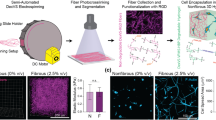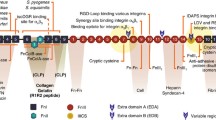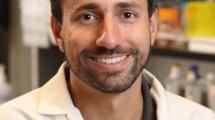Abstract
Interstitial fluid flow, critical for macromolecular transport, was recently shown to drive fibroblast differentiation and perpendicular cell and matrix alignment in 3D collagen cultures. Here we explore the mechanisms underlying this flow-induced cell and collagen alignment. Cell and matrix alignment was assessed from 3D confocal reflectance stacks using a Fast Fourier Transform method. We found that human dermal and lung fibroblasts align perpendicular to flow in the range of 5–13 μm/s (0.1–0.3 dyn/cm2) in collagen; however, neither cells nor matrix fibers align in fibrin cultures, which unlike collagen, is covalently cross-linked and generally degraded by cell fibrinolysis. We also found that even acellular collagen matrices align weakly upon exposure to flow. Matrix alignment begins within 12 h of flow onset and continues, along with cell alignment, over 48 h. Together, these data suggest that interstitial flow first induces collagen fiber alignment, providing contact guidance for the cells to orient along the aligned matrix; later, the aligned cells further remodel and align their surrounding matrix fibers. These findings help elucidate the effects of interstitial flow on cells in matrices and have relevance physiologically in tissue remodeling and in tissue engineering applications.





Similar content being viewed by others
REFERENCES
Barocas, V. H., T. S. Girton, and R. T. Tranquillo. Engineered alignment in media equivalents: Magnetic prealignment and mandrel compaction. J. Biomech. Eng. 120:660–666, 1998.
Brightman, A. O., B. P. Rajwa, J. E. Sturgis, M. E. McCallister, J. P. Robinson, and S. L. Voytik-Harbin. Time-lapse confocal reflection microscopy of collagen fibrillogenesis and extracellular matrix assembly in vitro. Biopolymers 54:222–234, 2000.
Chaudhuri, S., H. Nguyen, R. M. Rangayyan, S. Walsh, and C. B. Frank. A Fourier domain directional filtering method for analysis of collagen alignment in ligaments. IEEE Trans. Biomed. Eng. 34:509–518, 1987.
Choe, M. M., P. H. S. Sporn, and M. A. Swartz. An in vitro airway wall model of remodeling. Am. J. Physiol. Lung Cell Mol. Physiol. 285:L427–L433, 2003.
Costa, K. D., E. J. Lee, and J. W. Holmes. Creating alignment and anisotropy in engineered heart tissue: Role of boundary conditions in a model three-dimensional culture system. Tissue Eng. 9:567–577, 2003.
De Wever, O., and M. Mareel. Role of tissue stroma in cancer cell invasion. J. Pathol. 200:429–447, 2003.
Desmouliere, A., C. Guyot, and C. Gabbiani. The stroma reaction myofibroblast: A key player in the control of tumor cell behavior. Int. J. Dev. Biol. 48:509–517, 2004.
Eastwood, M., V. C. Mudera, D. A. McGrouther, and R. A. Brown. Effect of precise mechanical loading on fibroblast populated collagen lattices: Morphological changes. Cell Motil. Cytoskeleton 40:13–21, 1998.
Eckes, B., P. Zigrino, D. Kessler, O. Holtkotter, P. Shephard, C. Mauch, and T. Krieg. Fibroblast–matrix interactions in wound healing and fibrosis. Matrix Biol. 19:325–332, 2000.
Ehrlich, H. P., and T. M. Krummel. Regulation of wound healing from a connective tissue perspective. Wound Repair Regen. 4:203–210, 1996.
Farsi, J. M., and J. E. Aubin. Microfilament rearrangements during fibroblast-induced contraction of three-dimensional hydrated collagen gels. Cell Motil. 4:29–40, 1984.
Friedl, P., and E. B. Brocker. The biology of cell locomotion within three-dimensional extracellular matrix. Cell. Mol. Life Sci. 57:41–64, 2000.
Friedl, P., K. Maaser, C. E. Klein, B. Niggemann, G. Krohne, and K. S. Zanker. Migration of highly aggressive mv3 melanoma cells in 3-dimensional collagen lattices results in local matrix reorganization and shedding of alpha2 and beta1 integrins and CD44. Cancer Res. 57:2061–2070, 1997.
Friedl, P., K. S. Zanker, and E. B. Brocker. Cell migration strategies in 3-d extracellular matrix: Differences in morphology, cell matrix interactions, and integrin function. Microsc. Res. Technol. 43:369–378, 1998.
Girton, T. S., V. H. Barocas, and R. T. Tranquillo. Confined compression of a tissue equivalent: Collagen fibril and cell alignment in response to anisotropic strain. J. Biomech. Eng. 124:568–575, 2002.
Grinnell, F. Fibroblasts, myofibroblasts, and wound contraction. J. Cell Biol. 124:401–404, 1994.
Guido, S., and R. T. Tranquillo. A methodology for the systematic and quantitative study of cell contact guidance in oriented collagen gels. Correlation of fibroblast orientation and gel birefringence. J. Cell Sci. 105:317–31, 1993.
Happel, J., and H. Brenner. Low Reynolds Number Hydrodynamics. Dordrecht: Kluwer Academic Publishers, 1991, pp. 392–399.
Jenkins, G., K. L. Redwood, L. Meadows, and M. R. Green. Effect of gel re-organization and tensional forces on alpha 2 beta 1 integrin levels in dermal fibroblasts. Eur. J. Biochem. 263:93–103, 1999.
Lee, A. A., D. A. Graham, S. Dela Cruz, A. Ratcliffe, and W. J. Karlon. Fluid shear stress-induced alignment of cultured vascular smooth muscle cells. J. Biomech. Eng. 124:37–43, 2002.
Ng, C. P., C. L. E. Helm, and M. A. Swartz. Interstitial flow differentially stimulates blood and lymphatic endothelial cell morphogenesis in vitro. Microvasc. Res. 68:258–264, 2004.
Ng, C. P., B. Hinz, and M. A. Swartz. Interstitial fluid flow induces myofibroblast differentiation and collagen alignment in vitro. J. Cell Sci. 118:4731–4739, 2005.
Ng, C. P., and M. A. Swartz. Fibroblast alignment under interstitial fluid flow using a novel 3-d tissue culture model. Am. J. Physiol. Heart Circ. Physiol. 284:H1771–H1777, 2003.
Nishimura, T., and M. P. Ansell. Fast Fourier transform and filtered image analyses of fiber orientation in osb. Wood Sci. Technol. 36:287–307, 2002.
Palmer, B. M., and R. Bizios. Quantitative characterization of vascular endothelial cell morphology and orientation using Fourier transform analysis. J. Biomech. Eng. 119:159–165, 1997.
Pedersen, J. A., and M. A. Swartz. Mechanobiology in the third dimension. Ann. Biomed. Eng.33:1469–1490, 2005.
Pourdeyhimi, B., R. Dent, and H. Davis. Measuring fiber orientation in nonwovens, 3: Fourier transform. Text. Res. J. 67:143–151, 1997.
Schense, J. C., and J. A. Hubbell. Cross-linking exogenous bifunctional peptides into fibrin gels with factor xiiia. Bioconjug. Chem. 10:75–81, 1999.
Tomasek, J. J., G. Gabbiani, B. Hinz, C. Chaponnier, and R. A. Brown. Myofibroblasts and mechano-regulation of connective tissue remodelling. Nat. Rev. Mol. Cell Biol. 3:349–363, 2002.
Tranquillo, R. T. Self-organization of tissue-equivalents: The nature and role of contact guidance. Biochem. Soc. Symp. 65:27–42, 1999.
van Zuijlen, P. P. M., H. J. C. de Vries, E. N. Lamme, J. S. E. Coppens, J. van Marle, R. W. Kreis, and E. Middelkoop. Morphometry of dermal collagen orientation by fourier analysis is superior to multi-observer assessment. J. Pathol. 198:284–291, 2002.
Wang, D. M., and J. M. Tarbell. Modeling interstitial flow in an artery wall allows estimation of wall shear stress on smooth muscle cells. J. Biomech. Eng. 117:358–63, 1995.
Wang, J. H., and E. S. Grood. The strain magnitude and contact guidance determine orientation response of fibroblasts to cyclic substrate strains. Connect. Tissue Res. 41:29–36, 2000.
Wei, J., and M. B. Russ. Convection and diffusion in tissues and tissue-cultures. J. Theor. Biol. 66:775–787, 1977.
ACKNOWLEDGMENTS
This work was funded by grants from the Whitaker Foundation (RG-01-0348) and the National Science Foundation (BES-0134551).
Author information
Authors and Affiliations
Corresponding author
Rights and permissions
About this article
Cite this article
Ng, C.P., Swartz, M.A. Mechanisms of Interstitial Flow-Induced Remodeling of Fibroblast–Collagen Cultures. Ann Biomed Eng 34, 446–454 (2006). https://doi.org/10.1007/s10439-005-9067-3
Received:
Accepted:
Published:
Issue Date:
DOI: https://doi.org/10.1007/s10439-005-9067-3




